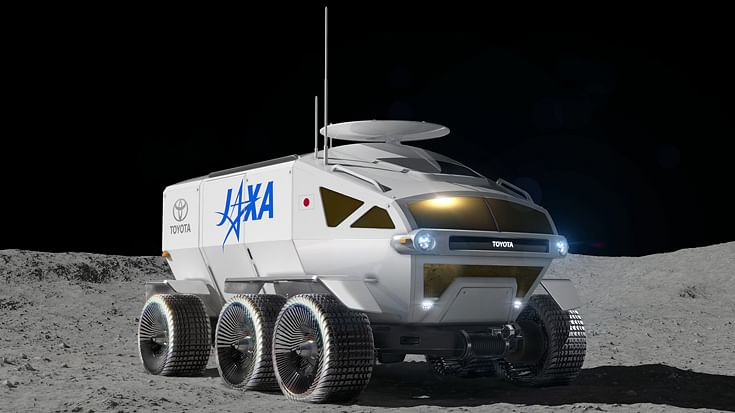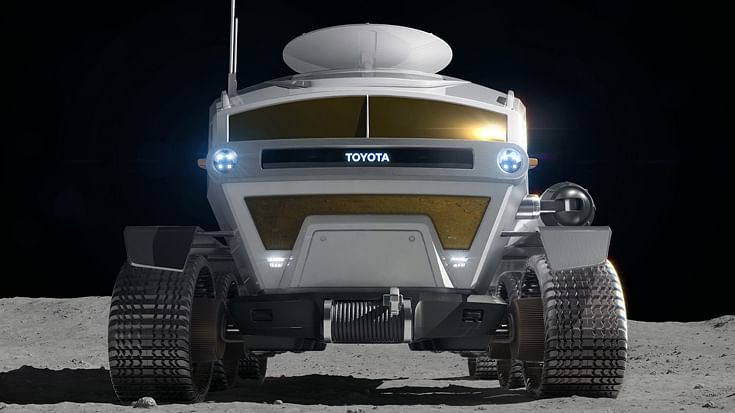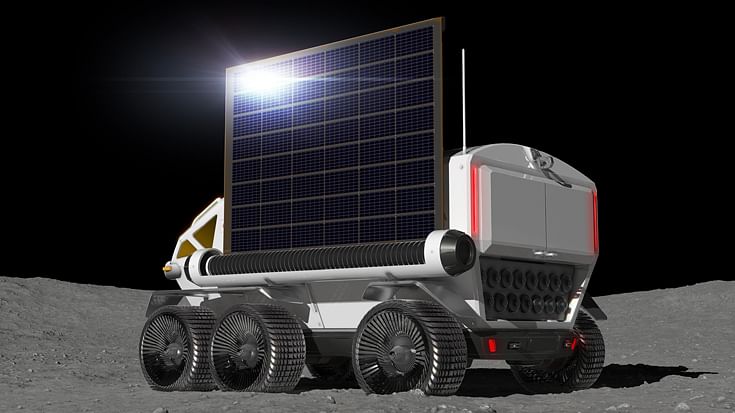JAXA, Toyota eye partnership for space exploration
The Japan Aerospace Exploration Agencyand Toyota have reached agreement to further cooperate on and accelerate their ongoing joint study of a manned, pressurised rover that employs fuel cell electric vehicle technologies.
The Japan Aerospace Exploration Agency (JAXA) and Toyota Motor Corporation (Toyota) are considering the possibility of collaborating on international space exploration.
As a first step, JAXA and Toyota have reached agreement to further cooperate on and accelerate their ongoing joint study of a manned, pressurised rover that employs fuel cell electric vehicle technologies. Such a form of mobility is deemed necessary for human exploration activities on the lunar surface. Even with the limited amount of energy that can be transported to the moon, the pressurised rover would have a total lunar-surface cruising range of more than 10,000km.

International space exploration, aiming to achieve sustainable prosperity for all of humankind by expanding the domain of human activity and giving rise to intellectual properties, has its sights set on the moon and Mars. To achieve the goals of such exploration, coordination between robotic missions, such as the recent successful touchdown by the asteroid probe Hayabusa2 on the asteroid Ryugu, and human missions, such as those involving humans using pressurized rovers to conduct activities on the moon, is essential. When it comes to challenging missions such as lunar or Martian exploration, various countries are competing in advancing their technologies, while also advancing their cooperative efforts.
JAXA President Hiroshi Yamakawa said: "At JAXA, we are pursuing international coordination and technological studies toward Japan's participation in international space exploration. We aim to contribute through leading Japanese technologies that can potentially generate spin-off benefits. Having Toyota join us in the challenge of international space exploration greatly strengthens our confidence. Manned rovers with pressurised cabins are an element that will play an important role in full-fledged exploration and use of the lunar surface. For this, we would like to concentrate our country's technological abilities and conduct technological studies. Through our joint studies going forward, we would like to put to use Toyota's excellent technological abilities related to mobility, and we look forward to the acceleration of our technological studies for the realisation of a manned, pressurised rover."
Toyota president Akio Toyoda said: "The automotive industry has long done business with the concepts of 'hometown' and 'home country' largely in mind. However, from now on, in responding to such matters as environmental issues of global scale, the concept of 'home planet', from which all of us come, will become a very important concept. Going beyond the frameworks of countries or regions, I believe that our industry, which is constantly thinking about the role it should fulfill, shares the same aspirations of international space exploration. Furthermore, cars are used in all of Earth's regions, and, in some regions, cars play active roles as partners for making sure that people come back alive. And I think that coming back alive is exactly what is needed in this project. I am extremely happy that, for this project, expectations have been placed on the thus-far developed durability and driving performance of Toyota vehicles and on our fuel cell environmental technologies."

Also, at a symposium held today in Tokyo, JAXA vice-president Koichi Wakata and Toyota executive vice-president Shigeki Terashi held a talk session.
JAXA’s Koichi Wakata said: "At JAXA, we are studying various scenarios as well as technologies that will be applied to specific space missions. Manned, pressurised rovers will be an important element supporting human lunar exploration, which we envision will take place in the 2030s. We aim at launching such a rover into space in 2029.
"Lunar gravity is one-sixth of that on Earth. Meanwhile, the moon has a complex terrain with craters, cliffs, and hills. Moreover, it is exposed to radiation and temperature conditions that are much harsher than those on Earth, as well as an ultra-high vacuum environment. For wide ranging human exploration of the moon, a pressurised rover that can travel more than 10,000km in such environments is a necessity. Toyota's 'space mobility' concept meets such mission requirements. Toyota and JAXA have been jointly studying the concept of a manned, pressurized rover since May of 2018.
"Thus far, our joint study, has examined a preliminary concept for a manned, pressurised rover system, and we have identified the technological issues that must be solved. Going forward, we want to utilise Toyota's and JAXA's technologies, human resources, and knowledge, among others, to continuously solve those issues.

Toyota’s Shigeki Terashi said: "As an engineer, there is no greater joy than being able to participate in such a lunar project by way of Toyota's car-making and, furthermore, by way of our technologies related to electrified vehicles, such as fuel cell batteries, and our technologies related to autonomous and automated driving. I am filled with great excitement.
"Fuel cells, which use clean power-generation methods, emit only water, and, because of their high energy density, they can provide a lot of energy, making them especially suited for the project being discussed with JAXA.
"Toyota believes that achieving a sustainable mobility society on Earth will involve the coexistence and widespread use of electrified vehicles, such as hybrid electric vehicles, plug-in hybrid electric vehicles, battery electric vehicles, and fuel cell electric vehicles. For electrification, fuel cell batteries represent an indispensable technology.
"Fuel cell electric vehicles have the ability to emit reduced amounts of harmful substances, such as particulate matter, that are found in the air they take in. As such, they are characterized by having so-called 'minus emissions'*3. We want to further improve on this characteristic.
"Contributing to Earth's environment cannot be achieved without the widespread use of electrified vehicles. As a full-line manufacturer of electrified vehicles, and aiming for the widespread use of such vehicles, Toyota―going beyond only making complete vehicles―wants to provide electrification to its customers in various forms, such as through systems and technologies.
Concept proposal for the pressurised rover
Length: 6.0 m;
Width: 5.2 m;
Height: 3.8 m (about the size of two microbuses)
Living space: 13m3
Capable of accommodating two people (four people in an emergency)
RELATED ARTICLES
Autoliv Plans JV for Advanced Safety Electronics With China’s HSAE
The new joint venture, which is to be located strategically near Shanghai and close to several existing Autoliv sites in...
JLR to Restart Production Over a Month After September Hacking
Manufacturing operations at the Tata Group-owned British luxury car and SUV manufacturer were shut down following a cybe...
BYD UK Sales Jump 880% in September to 11,271 units
Sales record sets the UK apart as the largest international market for BYD outside of China for the first time. The Seal...






 By Autocar Professional Bureau
By Autocar Professional Bureau
 12 Mar 2019
12 Mar 2019
 6862 Views
6862 Views
















 Ajit Dalvi
Ajit Dalvi




